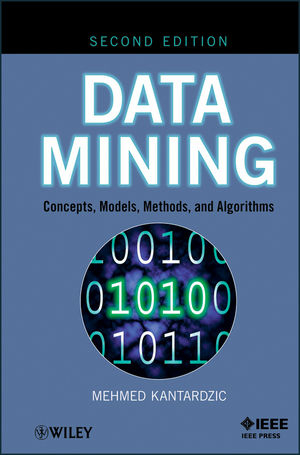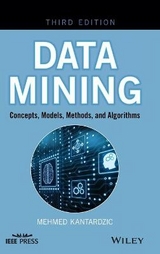
Data Mining
Wiley-Blackwell (Verlag)
978-0-470-89045-5 (ISBN)
- Titel ist leider vergriffen;
keine Neuauflage - Artikel merken
This book reviews state-of-the-art methodologies and techniques for analyzing enormous quantities of raw data in high-dimensional data spaces, to extract new information for decision making. The goal of this book is to provide a single introductory source, organized in a systematic way, in which we could direct the readers in analysis of large data sets, through the explanation of basic concepts, models and methodologies developed in recent decades. If you are an instructor or professor and would like to obtain instructor s materials, please visit http://booksupport.wiley.com If you are an instructor or professor and would like to obtain a solutions manual, please send an email to: pressbooks@ieee.org
MEHMED KANTARDZIC, PhD, is a professor in the Department of Computer Engineering and Computer Science (CECS) in the Speed School of Engineering at the University of Louisville, Director of CECS Graduate Studies, as well as Director of the Data Mining Lab. A member of IEEE, ISCA, and SPIE, Dr. Kantardzic has won awards for several of his papers, has been published in numerous referred journals, and has been an invited presenter at various conferences. He has also been a contributor to numerous books.
Preface to the Second Edition xiii Preface to the First Edition xv 1 DATA-MINING CONCEPTS 1 1.1 Introduction 1 1.2 Data-Mining Roots 4 1.3 Data-Mining Process 6 1.4 Large Data Sets 9 1.5 Data Warehouses for Data Mining 14 1.6 Business Aspects of Data Mining: Why a Data-Mining Project Fails 17 1.7 Organization of This Book 21 1.8 Review Questions and Problems 23 1.9 References for Further Study 24 2 PREPARING THE DATA 26 2.1 Representation of Raw Data 26 2.2 Characteristics of Raw Data 31 2.3 Transformation of Raw Data 33 2.4 Missing Data 36 2.5 Time-Dependent Data 37 2.6 Outlier Analysis 41 2.7 Review Questions and Problems 48 2.8 References for Further Study 51 3 DATA REDUCTION 53 3.1 Dimensions of Large Data Sets 54 3.2 Feature Reduction 56 3.3 Relief Algorithm 66 3.4 Entropy Measure for Ranking Features 68 3.5 PCA 70 3.6 Value Reduction 73 3.7 Feature Discretization: ChiMerge Technique 77 3.8 Case Reduction 80 3.9 Review Questions and Problems 83 3.10 References for Further Study 85 4 LEARNING FROM DATA 87 4.1 Learning Machine 89 4.2 SLT 93 4.3 Types of Learning Methods 99 4.4 Common Learning Tasks 101 4.5 SVMs 105 4.6 kNN: Nearest Neighbor Classifi er 118 4.7 Model Selection versus Generalization 122 4.8 Model Estimation 126 4.9 90% Accuracy: Now What? 132 4.10 Review Questions and Problems 136 4.11 References for Further Study 138 5 STATISTICAL METHODS 140 5.1 Statistical Inference 141 5.2 Assessing Differences in Data Sets 143 5.3 Bayesian Inference 146 5.4 Predictive Regression 149 5.5 ANOVA 155 5.6 Logistic Regression 157 5.7 Log-Linear Models 158 5.8 LDA 162 5.9 Review Questions and Problems 164 5.10 References for Further Study 167 6 DECISION TREES AND DECISION RULES 169 6.1 Decision Trees 171 6.2 C4.5 Algorithm: Generating a Decision Tree 173 6.3 Unknown Attribute Values 180 6.4 Pruning Decision Trees 184 6.5 C4.5 Algorithm: Generating Decision Rules 185 6.6 CART Algorithm & Gini Index 189 6.7 Limitations of Decision Trees and Decision Rules 192 6.8 Review Questions and Problems 194 6.9 References for Further Study 198 7 ARTIFICIAL NEURAL NETWORKS 199 7.1 Model of an Artifi cial Neuron 201 7.2 Architectures of ANNs 205 7.3 Learning Process 207 7.4 Learning Tasks Using ANNs 210 7.5 Multilayer Perceptrons (MLPs) 213 7.6 Competitive Networks and Competitive Learning 221 7.7 SOMs 225 7.8 Review Questions and Problems 231 7.9 References for Further Study 233 8 ENSEMBLE LEARNING 235 8.1 Ensemble-Learning Methodologies 236 8.2 Combination Schemes for Multiple Learners 240 8.3 Bagging and Boosting 241 8.4 AdaBoost 243 8.5 Review Questions and Problems 245 8.6 References for Further Study 247 9 CLUSTER ANALYSIS 249 9.1 Clustering Concepts 250 9.2 Similarity Measures 253 9.3 Agglomerative Hierarchical Clustering 259 9.4 Partitional Clustering 263 9.5 Incremental Clustering 266 9.6 DBSCAN Algorithm 270 9.7 BIRCH Algorithm 272 9.8 Clustering Validation 275 9.9 Review Questions and Problems 275 9.10 References for Further Study 279 10 ASSOCIATION RULES 280 10.1 Market-Basket Analysis 281 10.2 Algorithm Apriori 283 10.3 From Frequent Itemsets to Association Rules 285 10.4 Improving the Effi ciency of the Apriori Algorithm 286 10.5 FP Growth Method 288 10.6 Associative-Classifi cation Method 290 10.7 Multidimensional Association Rules Mining 293 10.8 Review Questions and Problems 295 10.9 References for Further Study 298 11 WEB MINING AND TEXT MINING 300 11.1 Web Mining 300 11.2 Web Content, Structure, and Usage Mining 302 11.3 HITS and LOGSOM Algorithms 305 11.4 Mining Path Traversal Patterns 310 11.5 PageRank Algorithm 313 11.6 Text Mining 316 11.7 Latent Semantic Analysis (LSA) 320 11.8 Review Questions and Problems 324 11.9 References for Further Study 326 12 ADVANCES IN DATA MINING 328 12.1 Graph Mining 329 12.2 Temporal Data Mining 343 12.3 Spatial Data Mining (SDM) 357 12.4 Distributed Data Mining (DDM) 360 12.5 Correlation Does Not Imply Causality 369 12.6 Privacy, Security, and Legal Aspects of Data Mining 376 12.7 Review Questions and Problems 381 12.8 References for Further Study 382 13 GENETIC ALGORITHMS 385 13.1 Fundamentals of GAs 386 13.2 Optimization Using GAs 388 13.3 A Simple Illustration of a GA 394 13.4 Schemata 399 13.5 TSP 402 13.6 Machine Learning Using GAs 404 13.7 GAs for Clustering 409 13.8 Review Questions and Problems 411 13.9 References for Further Study 413 14 FUZZY SETS AND FUZZY LOGIC 414 14.1 Fuzzy Sets 415 14.2 Fuzzy-Set Operations 420 14.3 Extension Principle and Fuzzy Relations 425 14.4 Fuzzy Logic and Fuzzy Inference Systems 429 14.5 Multifactorial Evaluation 433 14.6 Extracting Fuzzy Models from Data 436 14.7 Data Mining and Fuzzy Sets 441 14.8 Review Questions and Problems 443 14.9 References for Further Study 445 15 VISUALIZATION METHODS 447 15.1 Perception and Visualization 448 15.2 Scientifi c Visualization and Information Visualization 449 15.3 Parallel Coordinates 455 15.4 Radial Visualization 458 15.5 Visualization Using Self-Organizing Maps (SOMs) 460 15.6 Visualization Systems for Data Mining 462 15.7 Review Questions and Problems 467 15.8 References for Further Study 468 Appendix A 470 A.1 Data-Mining Journals 470 A.2 Data-Mining Conferences 473 A.3 Data-Mining Forums/Blogs 477 A.4 Data Sets 478 A.5 Comercially and Publicly Available Tools 480 A.6 Web Site Links 489 Appendix B: Data-Mining Applications 496 B.1 Data Mining for Financial Data Analysis 496 B.2 Data Mining for the Telecomunications Industry 499 B.3 Data Mining for the Retail Industry 501 B.4 Data Mining in Health Care and Biomedical Research 503 B.5 Data Mining in Science and Engineering 506 B.6 Pitfalls of Data Mining 509 Bibliography 510 Index 529
| Verlagsort | Hoboken |
|---|---|
| Sprache | englisch |
| Maße | 152 x 246 mm |
| Gewicht | 940 g |
| Themenwelt | Mathematik / Informatik ► Informatik ► Datenbanken |
| Mathematik / Informatik ► Informatik ► Netzwerke | |
| Informatik ► Weitere Themen ► Hardware | |
| Mathematik / Informatik ► Mathematik | |
| Technik ► Elektrotechnik / Energietechnik | |
| ISBN-10 | 0-470-89045-2 / 0470890452 |
| ISBN-13 | 978-0-470-89045-5 / 9780470890455 |
| Zustand | Neuware |
| Informationen gemäß Produktsicherheitsverordnung (GPSR) | |
| Haben Sie eine Frage zum Produkt? |
aus dem Bereich



